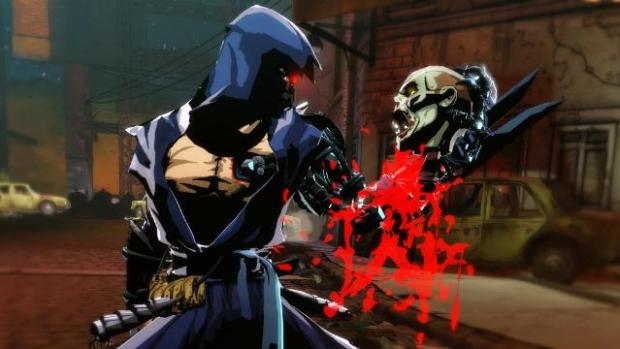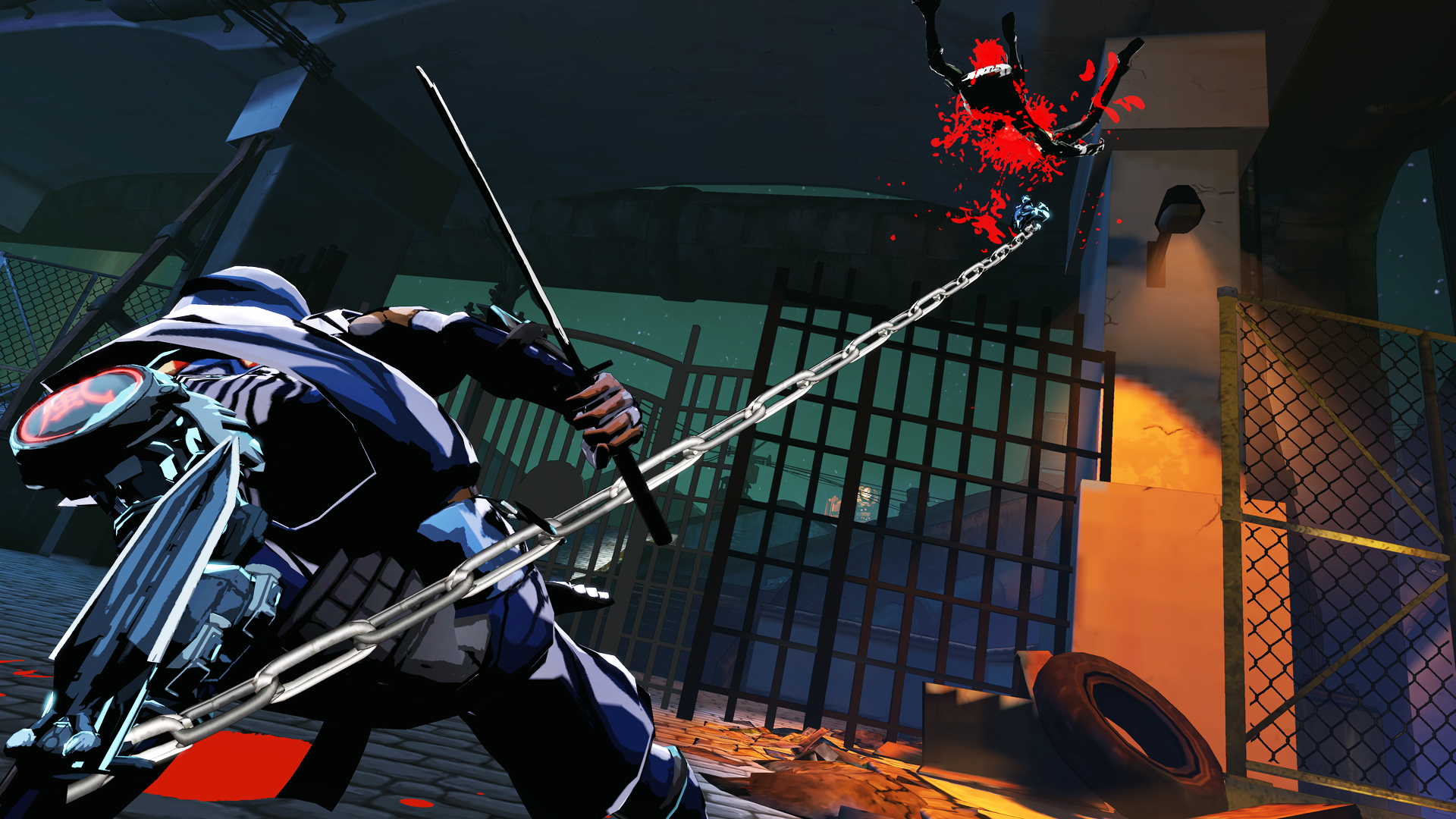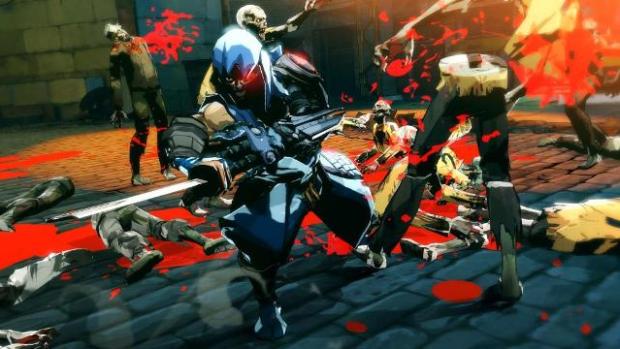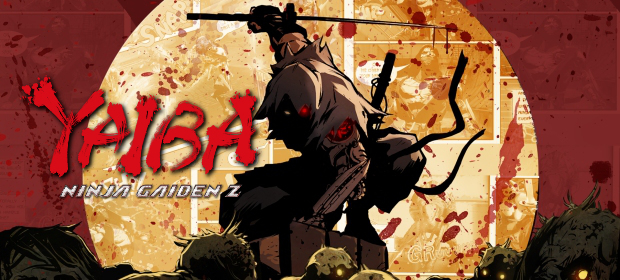When I think of Ninja Gaiden I think of flow. Difficulty, too, of course – but I recall a combat system that rewards timing, precision and reactionary movements to deal with the current enemy mix on screen. Ninja Gaiden, to me at least, is a series about owning a battle through smarts and reactions. Although, obviously, Yaiba isn’t a typical Ninja Gaiden (which is obvious from a mere glance), it does carry the moniker in subtitle, and so one would expect many tenets of the series to remain.
Anarchy is not a term I’d often associate with Ninja Gaiden, but anarchy is certainly the defining difference between Hayabusa and Yaiba. Well, that and crass language, a funky cel-shaded art style and zombies; but primarily, it’s anarchy. Yaiba’s fights are often a barely controllable mess in comparison to the scraps in the mainline series. Yaiba holds many of the tenets of Ninja Gaiden close to its putrid heart – not least of all difficulty – but it adds a new one: frustration. You might have found frustration in prior Ninja Gaiden games, but in Yaiba: Ninja Gaiden Z, frustration is a feature of almost every encounter.

The story focuses on the titular Yaiba, a ninja with the mouth of a sailor, who begins the game in a scrap with Ryu Hayabusa, in which he dies. You assume control of Yaiba weeks later when he reawakens with a metal arm and a robotic Iron Man-mimicking heart. And then – zombies! Zombies everywhere! Go kill the zombies! There’s vague framing from Miss Monday who informs you that a company run by Handsome Jack rip-off del Gonzo have put Yaiba back together in order to kill Ryu Hayabusa, because he’s ruining their stuff. But the story is told primarily through prepubescent writing found in the word documents you pick up during the stages. It’s basic stuff, but sure to elicit a giggle from more immature players.
What this does is set up Yaiba as a brash, silly and aggressive character, and these characteristics are successfully transferred to his combat style. Yaiba cannot jump, has a big metal hand to punch and pummel enemies with, and through the beefy power of the Unreal Engine, Yaiba: Ninja Gaiden Z’s combat comes across as something far weightier than previous Gaiden titles. Sure there aren’t any Izuna Drops or mid-air combo strings, but Yaiba hurls himself around arenas with unstoppable force.

Yaiba’s combat is fast, too. Your enemies may be zombies, but they don’t inform the gameplay as much as they do in, say, Lollipop Chainsaw. Lollipop was all about herding enemies together for big singular combos, but Yaiba’s combo count is very lenient and only resets upon taking damage. This does, however, put an emphasis on avoiding damage and, consequently, a big focus on dodging. That said, frequent dodging isn’t something new to the Gaiden series and is actually somewhat in keeping with the Hayabusa style. Issues arise when you mix in three things: signature enemies, projectiles and the counter technique.
Nearly every enemy in Yaiba: Ninja Gaiden Z that isn’t a basic shambler is an absolute sponge, and almost all of them are also capable of throwing area damaging projectiles around the arena. When you have more than one projectile-lobbing foe around, combat becomes a slow process of dealing small bits of damage while spamming the dodge button as you try to surmise a modicum of sense from the colourful vomit of zombie anarchy taking place on screen. The dodge technique isn’t 100% accurate, either, and you’ll frequently take damage when you think you should be clear of an attack. Crossing your fingers and hoping enemies kill each other is often the most viable tactic.

This wouldn’t be an issue if the counter technique wasn’t so infuriatingly strict and poorly implemented. To counter in Yaiba: Ninja Gaiden Z you need to press the block button the instant an attack strikes Yaiba. However, the signal to say that the incoming attack is counter-able occurs well before the actual attack, and the time between signal and onslaught varies from one enemy to the next. The lack of consistency, both in information and effective application, makes this essential technique frightfully and infuriatingly inconsistent and hard to integrate into the flow of a scrap.
And yet, there is some good to be found in Yaiba: Ninja Gaiden Z. The audio and visuals, particularly in cutscenes, are rather impressive, and the moments of QTE-flavoured platforming are visually satisfying in a Ninja Gaiden-meets-Bionic Commando sort of way. Attempting to weave a mix of fire, electricity and sludge into combat is good when it works, and the almost Streets of Rage-like application of temporary extra weapons is nice. There’s also the rather brilliant unlockable arcade mode that does away with the off-screen projectiles for single screen massacre, alongside wide-reaching arcade homage. This mode is very enjoyable, more so than the main game, even if it is still a victim of the inconsistent parry.

But the small good can’t remedy the fact that Yaiba’s locations are few and uninspired, its bosses largely lacking in ambition, its combat fundamentally flawed and its puzzle breaks little more than painfully contrived speed bumps. And in a five-six hour campaign, any filler is too much filler. You do get to watch zombies be silly though…
VERDICT: Yaiba: Ninja Gaiden Z is putrid, crass and brash. It makes no apologies for this, and if you’re in tune with the kamikaze ninja protagonist then the game’s style will carry you much of the way. Unfortunately, though, Yaiba’s chaotic nature has led to a combat system that throws away the usual finesse of its father franchise for something so anarchic it frequently borders on unplayable. At times this direction is inspired, but it’s often just frustrating to the point where you have to wonder if it’s deliberate.

POOR. Games tagged 4/10 will be playable, perhaps even enjoyable, but will be let down by a slew of negative elements that undermine their quality and value. Best avoided by any but hardcore genre fans.
Review code provided by publisher.





